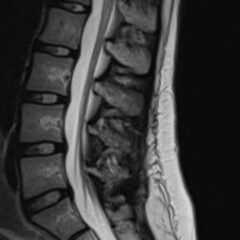Acute Flaccid Myelitis
ABSTRACT:
Audience:
Emergency medicine residents and medical students on emergency medicine rotation.
Introduction:
Although a somewhat rare disease, acute flaccid myelitis (AFM) can cause death, and for those pediatric patients that survive, less than 10% have full recovery.1 A cluster of cases that resembled polio was first described in California in 2012.2 After 120 cases of the disease were confirmed in 2014 in a 5-month period, the Centers for Disease Control and Prevention (CDC) began surveillance of the disease. Since surveillance began, clusters of cases have occurred in a biennial pattern, usually late summer and early fall. There were 218 cases between 2015 to 2017, 238 cases in 2018, 47 cases in 2019, and 32 in 2020.3,4,5 AFM has become recognized as a global disease with cases reported across many countries.1 The CDC has noted that the most common location of the first medical encounter of pediatric patients presenting with AFM is the emergency department in every year that surveillance occurred.5 Most of the children that are diagnosed with AFM are admitted to the hospital and of those admitted, 30% require intubation.5 Deaths related to AFM are due to respiratory involvement and complications. With appropriate recognition and supportive care, mortality can be avoided.
Educational Objectives:
At the end of this oral board session, examinees will: 1) demonstrate the ability to obtain a complete pediatric medical history; 2) demonstrate an appropriate exam on a pediatric patient including a neurological exam; 3) investigate the broad differential diagnoses for neuromuscular weakness in a pediatric patient; 4) order the appropriate evaluation studies including an MRI; 5) interpret the use of a negative inspiratory force in determining the need for intubation and level of care upon admission; and 6) demonstrate effective communication with parents and caregivers.
Educational Methods:
Oral board case following a standard American Board of Emergency Medicine-style case in a tertiary care hospital with access to all specialists and resources needed. This case was tested using 5 resident volunteers ranging from PGY 1 – 3 in an ACGME (Accreditation Council for Graduate Medical Education)-accredited emergency medicine program. Also, approximately 3 – 5 observers (other residents and medical students) were present during the presentation. Learners were immediately able to provide feedback during the debriefing of the case.
Research Methods:
Immediate Feedback was solicited from the learners and observers participating in the case both by verbal discussion and completion of a rating for the case following the debriefing. The efficacy of the educational content was assessed by comparing scoring measures across residents based on the training year. Scoring measures of the ACGME core competencies were performed using a scale from 1 – 8, 1- 4 being unacceptable performance and 5 – 8 being acceptable. Efficacy was assumed based on full completion of the case by the residents who acted as practice oral board candidates, and a debriefing session followed to discuss the key components of the case.
Results:
Practice candidates were 1 PGY1 level, 2 PGY2 Level and 2 PGY3 level residents. All residents that were practice candidates anchored on the diagnosis of Guillain-Barré Syndrome (GBS) but despite the anchoring were able to manage the patient appropriately and safely. The average score for practice candidates per level was: PGY1: 5.1, PGY2: 5.8, and PGY3: 6.5. The critical action missed by the PGY1 resident was ordering a negative inspiratory force and one PGY2 did not completely order all of the spinal MRI. All learners, both practice candidates and observers rated the case as 4.2 (1 – 5 Likert scale, 5 being excellent).
Discussion:
The educational content effectiveness was two-fold. The content was effective for teaching the presentation and appropriate evaluation to diagnose AFM. AFM is significantly like the presentation of poliomyelitis which originally occurred in sporadic cluster outbreaks and then the number of cases in the United States doubled every 4 – 5 years from 1940 – 1952.6 AFM is a disease that occurs in a biennial pattern and needs to be recognized and reported appropriately. The case also encouraged the cognizance of other etiologies for acute neuromuscular weakness in a pediatric patient which may require different diagnostic evaluation and medical management. AFM’ster clinical presentation generally involves asymmetric weakness and may occur in either an ascending or descending pattern with the nadir to maximum weakness attained in a few days. Although there are variants of GBS, the neuromuscular weakness is usually symmetrical and occurs in an ascending pattern with the nadir being reached in 1 – 2 weeks.7 AFM requires an MRI with specific abnormalities to meet the case definition while an MRI can be performed when GBS is suspected, but it is not necessary. AFM MRI abnormalities demonstrate brainstem and spinal cord lesions with a predominance of gray matter affected while a GBS MRI demonstrates ventral root abnormalities without any spinal cord or brainstem lesions. Without the MRI results, a patient may be assigned the incorrect diagnosis upon admission. A lumbar puncture and electromyography are required for the diagnosis of GBS. The cerebrospinal fluid (CSF) of GBS demonstrates high protein levels and white blood cell count (WBC) < 10 cells/mm3 while the CSF of AFM demonstrates pleocytosis although usually < 100 cells/mm3.1,8Electromyography will be abnormal in both GBS and AFM, but the test is not necessary for the diagnosis of AFM as it is with GBS. Both intravenous immunoglobulin (IVIG) and plasma exchange shorten the recovery time of GBS while there is no recommendation for treatment of AFM at this time. IVIG, plasmapheresis, and steroids have been utilized with unclear benefits.1,8 Physical therapy and occupational therapy appear to be significantly important in AFM with nerve transfer surgery as a possibility of cure to areas of muscles that have not recovered significant function in AFM.9 Reaching the appropriate diagnosis allows the emergency medicine physician to communicate more accurately with worried parents, providing them with correct information on treatment and progression of the disease.
Topics:
Pediatric weakness, pediatric neurologic disorders, acute flaccid myelitis, Gullian-Barré Syndrome, neuromuscular weakness.

